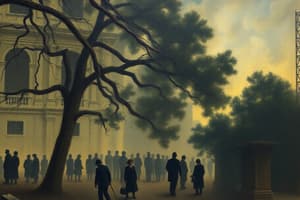Podcast
Questions and Answers
Which of these options are correct? (Select all that apply)
Which of these options are correct? (Select all that apply)
- It focuses on the need to deter crime through punishment. (correct)
- It emphasizes the role of free will and rational decision-making. (correct)
- It is concerned with understanding the underlying causes of crime.
- It assumes that people are naturally good.
What is the main idea behind the Broken Windows Theory?
What is the main idea behind the Broken Windows Theory?
- Broken windows directly cause crime by creating an environment that encourages criminal behavior.
- Broken windows represent a lack of social control in an area, signaling that crime is acceptable. (correct)
- Broken windows signify a decline in property values and a decrease in the standard of living.
- Broken windows are a metaphor for the breakdown of social order and the spread of crime. (correct)
The rational choice theory argues that criminal decisions are based on what principle?
The rational choice theory argues that criminal decisions are based on what principle?
The profit-loss/pleasure-pain principle.
What are the three key elements of routine activity theory that must come together for an offense to occur?
What are the three key elements of routine activity theory that must come together for an offense to occur?
Which of the following is NOT a criticism of situational crime prevention?
Which of the following is NOT a criticism of situational crime prevention?
Right realism emphasizes the importance of welfare programs in reducing crime.
Right realism emphasizes the importance of welfare programs in reducing crime.
What is the central argument of Right realism's Underclass theory?
What is the central argument of Right realism's Underclass theory?
What are the five stages of involvement decisions in rational choice theory?
What are the five stages of involvement decisions in rational choice theory?
What is one reason why crime rates did not decline with the post-war prosperity that occurred in many Western countries?
What is one reason why crime rates did not decline with the post-war prosperity that occurred in many Western countries?
Flashcards
Classical Criminology
Classical Criminology
A school of thought in criminology that emerged in the 18th century, emphasizing rational individuals making choices based on weighing potential pleasure against potential pain.
Cesare Beccaria
Cesare Beccaria
A key figure in classical criminology who argued that criminal behavior is a result of free will and rational decision-making, influenced by the potential for punishment.
Proportionality of Punishment
Proportionality of Punishment
The idea that punishment should be proportional to the severity of the crime, ensuring fair and consistent consequences.
Deterrence
Deterrence
Signup and view all the flashcards
Neo-Classicism
Neo-Classicism
Signup and view all the flashcards
Rational Choice Theory
Rational Choice Theory
Signup and view all the flashcards
Bounded Rationality
Bounded Rationality
Signup and view all the flashcards
Routine Activity Theory
Routine Activity Theory
Signup and view all the flashcards
Situational Crime Prevention
Situational Crime Prevention
Signup and view all the flashcards
Defensible Space
Defensible Space
Signup and view all the flashcards
Right Realism
Right Realism
Signup and view all the flashcards
Broken Windows Theory
Broken Windows Theory
Signup and view all the flashcards
The Underclass Theory
The Underclass Theory
Signup and view all the flashcards
Rational Choice Theory
Rational Choice Theory
Signup and view all the flashcards
Bounded Rationality
Bounded Rationality
Signup and view all the flashcards
Situational Crime Prevention
Situational Crime Prevention
Signup and view all the flashcards
Defensible Space
Defensible Space
Signup and view all the flashcards
Right Realism
Right Realism
Signup and view all the flashcards
Broken Windows Theory
Broken Windows Theory
Signup and view all the flashcards
The Underclass Theory
The Underclass Theory
Signup and view all the flashcards
Classical Criminology
Classical Criminology
Signup and view all the flashcards
Cesare Beccaria
Cesare Beccaria
Signup and view all the flashcards
Proportionality of Punishment
Proportionality of Punishment
Signup and view all the flashcards
Deterrence
Deterrence
Signup and view all the flashcards
Neo-Classicism
Neo-Classicism
Signup and view all the flashcards
Rational Choice Theory
Rational Choice Theory
Signup and view all the flashcards
Bounded Rationality
Bounded Rationality
Signup and view all the flashcards
Routine Activity Theory
Routine Activity Theory
Signup and view all the flashcards
Situational Crime Prevention
Situational Crime Prevention
Signup and view all the flashcards
Defensible Space
Defensible Space
Signup and view all the flashcards
Study Notes
Rational Actor Explanations for Crime
- Criminological theories are categorized into four groups: Rational Actor Explanations, Pre-Destined Actor Explanations, Victimised Actor Explanations, and Integrated Explanations.
- Classical Criminology posits that crime occurs when the perceived benefits outweigh the costs (pleasure vs. pain).
- Key figures in classical criminology include Cesare Beccaria and Jeremy Bentham, who both advocated for legal and penal reforms to make the criminal justice system more proportionate and rational.
- Beccaria argued that all individuals capable of crime, that human behaviour is based on rational calculation about the pleasure or pain of actions, and punishment should be proportionate to the crime.
- Contemporary Classicism includes rational choice theories, routine activities theory, and situational crime prevention, highlighting the individual's decision-making process.
- Right realism builds upon these contemporary theories, focusing on reducing opportunities for crime and maintaining order by emphasizing punishment instead of considering socio-economic factors in relation to crime.
Neo-Classicism
- Neo-classicism revises the free will doctrine by acknowledging that some individuals are less able to exercise free will and act rationally, like those with mental illnesses or children.
- It recognizes "mitigating circumstances", such as certain demographics or backgrounds of people to consider during sentencing.
- Modern Criminal Justice Systems are frequently based upon neo-classicism, typically employing harsher sentences, consistency, and less flexibility in sentencing.
Contemporary Rational Actor Explanations/Contemporary Classicism
- Interest in classical crime explanations declined in the mid-1800s and subsequently expanded into biological, psychological, and sociological factors around the 1970s to 1980s.
- The resurgence of classical explanations is partly due to a renewed interest in economic and social beliefs.
- Biological, psychological, and sociological theories are less helpful when addressing the causes of crime.
Rational Choice Theory
- Rational Choice Theory draws on classicism, arguing that people commit crimes based on the profit-loss/pleasure-pain principle to maximize profit and minimize losses.
- Decisions are rational, emphasizing the importance of perceived risk and uncertainty in crime.
- The theory involves six propositions:
- Crimes are purposive and benefit the offender.
- Offenders aim to make the best decisions based on perceived risks and uncertainty
- Decisions about crime vary based on the nature of the crime and benefits.
- Decisions about involvement in crime differ from decisions about committing crimes.
- Decisions about involvement in crime have three stages; initiation, habituation and desistance.
- Event decisions consist of a series of choices involving, preparation, target selection, escape, and aftermath.
- Crime scripts are step-by-step accounts of decision-making in particular crimes.
Routine Activity Theory
- Crime rates did not decline with post-war prosperity.
- Social changes created new crime opportunities, such as more targets (e.g., cars, high-value electronic devices), and reduced guardianship (e.g., more households left unguarded during the day), and changes in how people live their lives.
- Cohen and Felson theorized that crime occurs when three elements converge: motivated offenders, suitable targets, and the absence of capable guardians.
- Target selection can depend on four criteria: value, inertia, visibility and access.
Situational Crime Prevention
- Situational crime prevention builds on rational choice and routine activity theories.
- It aims to reduce crime opportunities through methods like designing out crime, manipulating environments to make crimes more difficult, such as installing surveillance measures (e.g. CCTV cameras), and removing incentives and excuses (e.g., clear rules and instructions).
- Examples include adding car steering locks to prevent thefts and installing hotlines to pizza makers to stop crowds gathering outside the restaurant.
Right Realism
- Right Realism emerged in the USA and UK in the 1970s-80s, emphasizing neo-liberal economic beliefs and minimal government intervention in the economy and the political right.
- Key thinkers, like Wilson and Kelling, proposed the broken windows theory, suggesting that disorder (e.g., graffiti, noise) creates an environment conducive to more serious crime.
- Other figures in Right Realism, such as Charles Murray, focussed on welfare state dependency, lone-parent families and a lack of appropriate male role models as factors contributing to crime.
- Right Realism advocates for policies focused on controlling crime, improving policing, implementing strict rules with swift punishments, eradicating incivilities, and reducing welfare dependence.
Critiques of Rational Choice, Routine Activity, and Right Realism
- Assumes everyone will commit crime if opportunity arises.
- Inadequate consideration of other factors like biological, psychological, and sociological factors.
- Policies may lead to repressive measures, like increased surveillance and restrictions on freedom, disproportionately effecting less privileged groups, such as the poor.
Studying That Suits You
Use AI to generate personalized quizzes and flashcards to suit your learning preferences.




